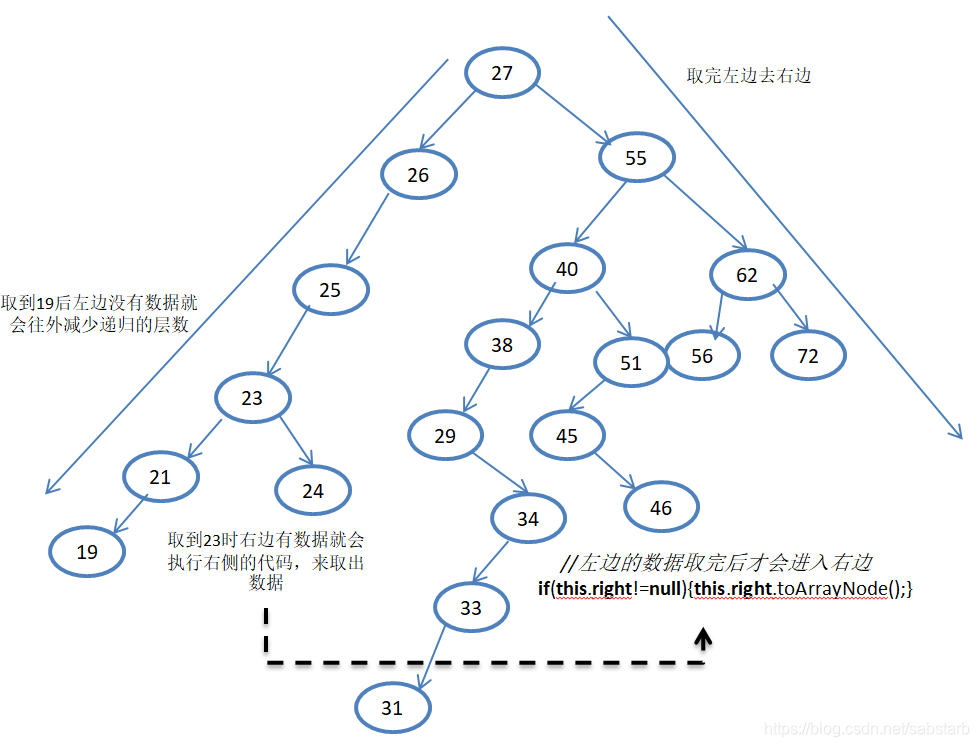Cuatro lograr la eliminación de datos binario
1, los datos de borrado no hay niños
2, eliminar los datos mientras que no tienen nodos secundarios
3, suprimir el nodo hijo izquierdo y el nodo hijo derecho no está vacía
4, elimine el nodo raíz
Ejemplo:
Con referencia a la figura:

interface Two<T> {
public void add(Comparable<T> data);
public int size();
public Object[] toArray();
public boolean inquire(T data);
public void remove(T data);
}
class TwoImpl<T> implements Two<T> {
private Node root;
private int size;
private int footer;
private Object[] resultData;
@Override
public void add(Comparable<T> data) {
if (data == null) {
return;
}
Node node = new Node(data);
if (this.root == null) {
this.root = node;
} else {
this.root.addNode(this.root, node);
}
++this.size;
}
@Override
public int size() {
return this.size;
}
@Override
public Object[] toArray() {
if (this.size() == 0) {
return null;
}
this.footer = 0;
this.resultData = new Object[this.size];
this.root.toArrayNode();
return this.resultData;
}
@Override
public boolean inquire(T data) {
if (this.size() == 0) {
return false;
}
return this.root.inquireNode(data);
}
@Override
public void remove(T data) {
if (this.inquire(data)) {
if (this.root.data.compareTo(data) == 0) {
this.root = this.delete(data);
} else {
this.delete(data);
}
--this.size;
}
}
private Node delete(T data) {
Node sonNode = null;
Node thisNode = this.root.removeNode(data);
if (thisNode.right == null && thisNode.left == null) {
if (thisNode.parent != null) {
if (thisNode.parent.data.compareTo(data) <= 0) {
thisNode.parent.right = null;
} else {
thisNode.parent.left = null;
}
}
thisNode.parent = null;
}
if ((thisNode.right != null && thisNode.left == null)
|| (thisNode.right == null && thisNode.left != null)) {
if (thisNode.right != null) {
sonNode = thisNode.right;
} else {
sonNode = thisNode.left;
}
if (thisNode.parent != null) {
if (thisNode.parent.data.compareTo(data) <= 0) {
thisNode.parent.right = sonNode;
} else {
thisNode.parent.left = sonNode;
}
}
sonNode.parent = thisNode.parent;
}
if (thisNode.left != null && thisNode.right != null) {
sonNode = thisNode.right;
while (sonNode.left != null) {
sonNode = sonNode.left;
}
if (thisNode.right != sonNode) {
sonNode.parent.left = null;
}
if (sonNode.right != null) {
sonNode.parent.left = sonNode.right;
sonNode.right.parent = sonNode.parent;
}
sonNode.parent = thisNode.parent;
if (thisNode.right != sonNode) {
sonNode.right = thisNode.right;
}
sonNode.left = thisNode.left;
if (thisNode.parent != null) {
if (thisNode.parent.data.compareTo(data) <= 0) {
thisNode.parent.right = sonNode;
} else {
thisNode.parent.left = sonNode;
}
}
}
return sonNode;
}
private class Node {
private Comparable<T> data;
private Node left;
private Node right;
private Node parent;
public Node(Comparable<T> data) {
this.data = data;
}
public void addNode(Node parentNode, Node node) {
if (this.data.compareTo((T) node.data) <= 0) {
if (this.right == null) {
this.right = node;
node.parent = parentNode;
} else {
this.right.addNode(this.right, node);
}
} else {
if (this.left == null) {
this.left = node;
node.parent = parentNode;
} else {
this.left.addNode(this.left, node);
}
}
}
public void toArrayNode() {
if (this.left != null) {
this.left.toArrayNode();
}
TwoImpl.this.resultData[TwoImpl.this.footer++] = this.data;
if (this.right != null) {
this.right.toArrayNode();
}
}
public boolean inquireNode(T data) {
if (this.data.compareTo(data) == 0) {
return true;
} else {
if (this.data.compareTo(data) < 0) {
if (this.right != null) {
return this.right.inquireNode(data);
} else {
return false;
}
} else {
if (this.left != null) {
return this.left.inquireNode(data);
} else {
return false;
}
}
}
}
public Node removeNode(T data) {
if (this.data.compareTo(data) == 0) {
return this;
} else {
if (this.data.compareTo(data) < 0) {
return this.right.removeNode(data);
} else {
return this.left.removeNode(data);
}
}
}
}
}
public class Demo01 {
public static void main(String[] args) {
Two<Member> two = new TwoImpl<>();
two.add(new Member("孙七", 27));
two.add(new Member("赵六", 26));
two.add(new Member("王五", 25));
two.add(new Member("张三", 23));
two.add(new Member("李四1", 24));
two.add(new Member("李四2", 55));
two.add(new Member("李四3", 40));
two.add(new Member("李四4", 38));
two.add(new Member("李四5", 29));
two.add(new Member("李四6", 21));
two.add(new Member("李四7", 19));
two.add(new Member("李四11", 62));
two.add(new Member("李四8", 51));
two.add(new Member("李四9", 34));
two.add(new Member("李四10", 56));
two.add(new Member("李四12", 72));
two.add(new Member("李四13", 45));
two.add(new Member("李四46", 46));
two.add(new Member("李四14", 33));
two.add(new Member("李四15", 31));
two.remove(new Member("孙七", 27));
System.out.println(Arrays.toString(two.toArray()));
}
}
resultados:
[name='李四7, age=19
, name='李四6, age=21
, name='张三, age=23
, name='李四1, age=24
, name='王五, age=25
, name='赵六, age=26
, name='李四5, age=29
, name='李四15, age=31
, name='李四14, age=33
, name='李四9, age=34
, name='李四4, age=38
, name='李四3, age=40
, name='李四13, age=45
, name='李四46, age=46
, name='李四8, age=51
, name='李四2, age=55
, name='李四10, age=56
, name='李四11, age=62
, name='李四12, age=72
]

